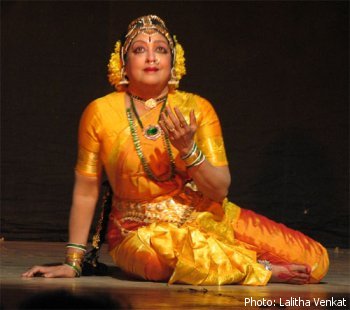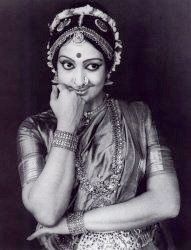
|
 |

|
 |
Padma Subrahmanyam: We must respect our heritage - Lalitha Venkat November 26, 2008  Padma Subrahmanyam (Director, Nrityodaya, Chennai) is acclaimed as a rare combination of a dancer, research scholar, choreographer, music composer, singer, teacher, author, Indologist and one of the most outstanding artistes of today. Encouraged by her father, Padma Subrahmanyam started learning under Kausalya who was a young teacher at Nrityodaya, the dance school founded by her father in 1942. Later, she came under the wings of guru Vazhuvoor Ramaiah Pillai and had her arangetram in 1956. Recognizing her talent, her father helped her further her capabilities. From Dandayuthapani Pillai, she learnt adavus, from Gowri Ammal she learnt abhinaya. From various devadasis, she learnt 150 different adavus. Thus began her research. Padma scores the music for most of her productions apart from numerous individual compositions. She has designed the sculptures of the 108 Karanas of Lord Siva and Godess Parvati in black granite for the Nataraja temple at Satara in Maharashtra, an undertaking she took on at Kanchi Paramacharya's bidding. She has numerous articles, research papers and travelogues to her credit like "Bharata's Art - then and now", "Bharatakkalai Kotpadu" (in Tamil), "Natya Sastra and National Unity." 'Legacy of a Legend' is a collection of articles by her. You have said, "The Natyasastra says a production must be such that a family should be able to watch it together." What about the erotic padams or violence/wars in the epics? The Natyasastra gives an ethical view and what is decency. It is up to the artistes to choose what they want. As water finds its level, audience find their artiste.  The relevance of Ramayana themes in today's context. The Ramayana, Mahabharata, Bhagavata and all our scriptures are relevant beyond time and space. It is not a loss for the author if this relevance is not understood today. It is for us to respect our heritage and follow the timeless values they offer us. I hope ego born out of ignorance does not overcome humility to appreciate heritage. Your favorite compositions of Rama that you like to dance to. I have performed 'Ramaya Thubhyam Namaha' which is a compilation from five Ramayanas. This question is like asking which part of the sugarcane is sweet. You have set Jatayu Moksham (in Ramayana) to the Tchaikovsky's ballet Romeo and Juliet. What is your inspiration? As I was listening to Tchaikovsky's overture to Romeo and Juliet, as a student of western music, I was very touched and involved that the scenes from the Ramayana appeared in my mental eye. My entire choreography for the 20 minute piece came to my mind instantaneously. It actually starts with Surpanakha entering Rama's ashrama and ends with Rama bestowing moksha on Jatayu. The fact is that I never strained my brain. The dance movements necessary for the communication of events and emotions relating to the episodes of the Ramayana were in my mental picture as I was lying down and relaxing, listening to the music. A few weeks later, I was surprised that I was invited to perform at the Festival of India in the then Soviet Union. I presented this for the first time in Moscow and other cities in Soviet Union and other parts of the world as well. In Moscow, the reception for this number was amazing. The Russian media described the performance as, "uniting the souls of India with that of Russia" and also mentioned that it looked as though Tchaikovsky anticipated my dance and composed for which I danced 75 years later. But what was more surprising was that this was a great success in Chennai at the Music Academy, when the most respected veteran musician Sri. Semmangudi maama also joined the audience in a standing ovation. I do not know why I took up the Ramayana episode for this music. It was nothing but Kriya Sakthi's grace. Your point of view on Ramayana in the performing arts. Ramayana has been a favourite theme for literature, music, dance, drama, painting, and sculpture for all strata of the society at all times not only in India but throughout Asia. It had also been extremely popular on the stage in Russia. You have written a book titled 'Bhagavad Gita for Dance.' Any plans to write one on Ramayana for dance? I have not thought about it. Your comment on the Chennai season. The month of Margazhi (14th December to 14th January) is traditionally known for prayer through nama sankeertanam. The extension of that holy concept is the Chennai music season which directly or indirectly kindles religious and spiritual values along with aesthetic values. One may say that it is a maddening season with hundreds of festivals all over Chennai. If somebody is maddened by music and dance, it leads to an inner peace which the world needs at this hour of constant conflict and terror. The sound of our percussion is thousand times better than the country bombs. Contact: C/o e-mail: kannanveena@hotmail.com |